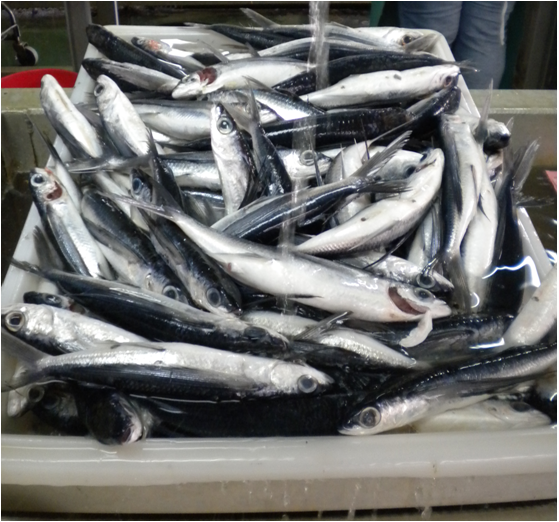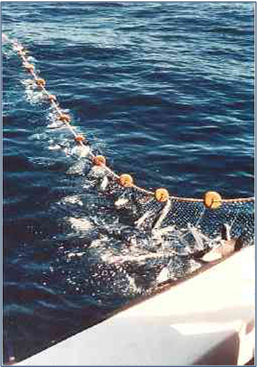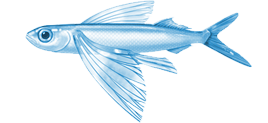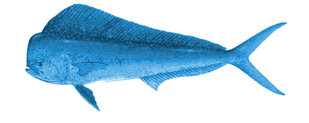FLYINGFISH FISHERY CASE STUDY
Introduction
The family of marine fishes; Exocoetidae, are commonly referred to as the flyingfishes. There are about 64 species of flyingfish living mainly in tropical and warm subtropical waters. Flyingfishes have unusually large wing-like pectoral fins, which can be as much as 60 to 70 % of the standard length of the fish. These large pectoral fins are used for gilding through the air a few feet above the water's surface and thus the common name “the flyingfish”. It is believed that the fish leaps out of the water and glides through the air to hide and escape from predators.
It is envisioned that a functional policy and management cycle with appropriate linkages to National, regional and global cycles will be established for the flyingfish fishery of the Eastern Caribbean.
Twelve (12) species of flyingfish can be found in the Eastern Caribbean. Of the twelve species, the four-winged flyingfish (Hirundicthys affinis) is the species occurring most often in the catches of fishermen of the Eastern Caribbean, accounting for about 90% of all flyingfish landed in Barbados, and dominating the flyingfish landings of Grenada, Trinidad and Tobago and St. Lucia. In fact, the four-winged flyingfish (Hirundichthys affinis) fishery is the single most important small pelagic fishery in the southern Lesser Antilles.
The flyingfish fishery of the Eastern Caribbean is a shared resource which is exploited by seven countries including Trinidad and Tobago, Grenada, St. Vincent and the Grenadines, Barbados, St. Lucia, Dominica and France (Martinique). For these countries, there is a high social and economic dependence on the fishery. The maximum total annual landings of flying fish for these countries is –4700 mt.
This Case Study will review and complete the transboundary diagnostic analysis of the fishery and identify and analyse the priority transboundary problems and issues including the underlying and root causes.
Over 1700 boats are engaged in this fishery which is pursued from a variety of small to medium scale vessels operating from numerous and often rural landing sites in the participating countries. Gears used to capture flyingfish include gill nets, dip nets and hook and line. Most of the catch landed is used as food and there is considerable value added to the catch from the onshore processing and distribution of the fish. For example in Barbados the landed value of the catch between 1999 and 2003 was about US$ 1.8 million annually with the added value being a further US$ 13.8 million per year for a total value of US$ 15.6 M. Flyingfish is also important as a bait fish for the long line fishery of the region.
Flyingfish fillets after processing
Through the 1980’s there was an increasing trend in landings owing to the rapid expansion of the fleet and area fished. During this period the fishing fleet in Barbados expanded rapidly and total landings of flyingfish more than doubled. This led to concern that the resource may become overfished and to increased attention to acquiring the information needed for management.
Beneficiaries are all who earn a living from flyingfish and consumers. Tourism may benefit from availability of a highly popular Caribbean seafood dish. Countries may benefit from reduction in cost of importing seafood for consumption.

To establish a regular subregional management and policy cycle for the flyingfish that: utilizes the best available information from all sources, develops a regional management plan, provides advice to a decision-making body, makes and implements decisions.
.Goal
The aim of the Eastern Caribbean Flyingfish Fishery Case Study is to complete a Transboundary Diagnostic Analysis (TDA) of the fishery and identify and analyse the priority transboundary problems and issues including the underlying and root causes and then using this information to inform the development of the Strategic Action Programme (SAP) which outlines the policy, legal and institutional reforms and investments needed to address the priority transboundary problems identified.
Objective
The CRFM flyingfish project seeks to promote the sustainable management of shared living marine resources of the wider Caribbean region by addressing important knowledge gaps on the fourwinged flyingfish fishery as well as informing the development of CLME management and governance frameworks that outline priority actions for this fishery within the Eastern Caribbean.
.Geographic Scope
The general study area of the case study is the eastern Caribbean, particularly the areas of the southern Lesser Antilles. The seven countries: Barbados, Dominica, France (Martinique), Grenada, St. Lucia, St. Vincent and the Grenadines and Trinidad and Tobago, which fish this resource areparticipating in this case study.
A Map of the Eastern Caribbean.


A focus of the CLME Project will be to address the challenges of sustainable use of shared living marine resources through the concept of Ecosystem Based Management (EBM). EBM links the various sectors that share the use of marine ecosystems, e.g. fisheries, tourism, shipping, energy, and addresses complexity.
Project Components
TDA Gap Filling Activities
-Improvement of availability of data and information including catch/effort information
- Bioeconomic analysis of the fishery
SAP Gap Filling Activities
- Stakeholder analysis including assessment of capacity to take part in the regional management process.
- Evaluate existing policy cycles and linkages of countries involved in the fishery.
- Prepare a report on the combined findings of assessments reports; the stakeholder analysis; review of the existing policy, legal and institutional framework and cycles and recommend reforms needed to achieve sustainable governance and management of the flyingfish resources. Back to Top
Expected Outcomes
- A bioeconomic assessment and established bi
oeconomic management criteria to guide management planning and decision making for flyingfish fishery.-Management recommendations on the Eastern Caribbean fourwinged flyingfish taking into account social and economic objectives and the Ecosystem Approach to Fisheries (EAF).
- MOU on cooperation between the CRFM and France (Martinique) prepared and executed.
-Sub-regional Declaration/Plan of Action completed, and endorsed by policy makers from the participating States.
-To contribute to the development of the final TDA and fill in knowledge and data gaps on the Eastern Caribbean flyingfish fishery.
- To contribute to the development Strategic Action Programme and inform the management and governance framework for the eastern Caribbean flyingfish fishery

POSTAL ADDRESS: Edificio Chambacú - Oficina 405, Cra 13B# 26-78, Cartagena de Indias, Bolívar, Colombia
EMAIL: info@clmeproject.org



